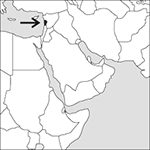
Source: MAPS IN MINUTES™ © RH Publications (1997)
Capital:
Beirut
Area:
10,400 sq km (4015 sq miles)
Population:
4,131,583 (2013 est)
Currency:
1 Lebanese pound = 100 piastres
Religions:
Muslim 59.7%; Christian 39.0%
Ethnic Groups:
Arab 95.0%; Armenian 4.0%
Languages:
Arabic (official); French; English; Armenian
International Organizations:
UN; Arab League; Non‐Aligned Movement
A country of the Middle East at the eastern end of the Mediterranean Sea, bounded by Syria on the north and east and Israel on the south.
Physical
Lebanon is some 200 km (125 miles) from north to south and 50–80 km (30–50 miles) from east to west. On the narrow coastal plain summers are sunny and warm; fruits of all kinds grow well. Inland the ground rises quickly, to two ranges of high mountains, where there is much winter frost and snow. Between them is the fertile Bekaa Valley, well suited to agriculture, while much of the eastern boundary resembles steppe.
Economy
Lebanon is the financial centre for its region—a position it has worked hard to recover after the destruction of the 1975–90 civil war. Other industries include tourism, food processing, wine, and jewellery; the principal agricultural products are fruit and vegetables. Exports include jewellery, metals, chemicals, consumer goods, and fruit and vegetables.
History
Much of present‐day Lebanon formed part of Phoenicia, including the important trading towns of Tyre, Sidon, Byblos, and Arvad, which retained their importance under Roman rule. Mount Lebanon was a refuge for persecuted minorities such as the Christian Maronites, who settled there from the 7th century ad, and the Muslim Druze, who occupied the southern part of the mountain from the 11th century. After the Arab conquest during the 7th century Arab tribesmen settled in Lebanon. Successive governments in the region usually left the people of the mountain to manage their own affairs and contented themselves with exercising authority on the coastal plain. Part of the Ottoman empire from the 16th century, it became a French mandate after World War I. A Lebanese republic was set up in 1926. The country was occupied (1941–45) by Free French forces, supported by Britain.
Independence was achieved in 1945. Growing disputes between Christians and Muslims, exacerbated by the presence of Palestinian refugees, undermined the stability of the republic. Hostility between the differing Christian and Muslim groups led to protracted civil war and to the armed intervention (1976) by Syria. The activities of the Palestine Liberation Organization brought large‐scale Israeli military invasion and led to Israeli occupation (1978) of a part of southern Lebanon. A UN peacekeeping force attempted unsuccessfully to set up a buffer zone. A full military invasion (1982) by Israel led to the evacuation of the Palestinians. A massacre by the Phalangist Christian militia in Israeli‐occupied West Beirut of Muslim civilians in the Chabra and Chatila refugee camps brought a redeployment of UN peacekeeping forces. Syria again intervened in 1987. Israel established a South Lebanon Army (SLA), and there were 20 Israeli air raids during 1988. In March 1989 the Maronite Christian General Aoun launched an all‐out war against Syrian troops. In October 1989 the Arab League successfully negotiated an accord in Taif, Saudi Arabia, whereby the Maronite dominance in government would be reduced. This was reluctantly accepted, and a frail peace established under continued Syrian protection, which was formalized by a treaty in May 1991. In 1992 the first general elections since 1972 were largely boycotted by Maronite Christian parties. Rafik Hariri became Prime Minister (1992–98; 2000–04) and began to implement a programme of economic reconstruction. Tension in southern Lebanon continued, with attacks by the radical, Iran‐backed Hezbollah guerrillas against the Israeli‐supported SLA. In 2005 Hariri was assassinated. Suspected Syrian involvement led to large demonstrations and the withdrawal of all Syrian troops from Lebanon. In 2006 a month-long Israeli military operation against Hezbollah caused economic damage in south Lebanon. Hezbollah used its enhanced prestige from this conflict to demand a greater role in Lebanon’s government, which led to political stalemate. Armed clashes in Beirut between government and Hezbollah in 2008 resulted in Hezbollah being given a veto over government decisions.
Much of Lebanon’s politics is still dominated by the relationship with Syria. Since 2005the main division has been between the March 8 Alliance, led by Najib Mikati, which wants to keep Lebanon within Syria's sphere of influence, and the March 14 Bloc, led by Saad Hariri (son of the former Prime Minister), which wants to move Lebanon into the embrace of Saudi Arabia, France, and the USA. Mikati served as Prime Minister from 2011 to 2014, heading a government that was dominated by the Hezbollah group; he was succeeded by Tammam Salam, a consensus candidate, in 2014 and then bySaad Hariri in 2016. There is an ongoing refugee crisis: by the end of 2016 there were over one million Syrian refugees in Lebanon, a quarter of the country’s total population.
- Brigantes
- Brigantian
- Briggs, Henry
- Briggs, Henry (1561–1630)
- brighteners
- Bright, John (1811–89)
- bright nebula
- brightness temperature
- bright spot
- Bright Star Catalogue
- Brillat-Savarin, Jean Anthelme (1755–1826)
- Brillinger, David Ross (1937– )
- Brillouin spectroscopy
- Brillouin zone
- brine
- Brinell hardness
- Brinell hardness number
- Brin process
- Brin, Sergey (1973–)
- Brioverian
- bristlecone pine
- Britain
- Britain, Battle of (August–October 1940)
- Britannia metal
- British Association of Remote-Sensing Companies